Should I begin by saying the most awesome airplane that ever was is the Corsair? Sure there are those who would quickly disagree with me and cite all sorts of hard data and common knowledge – but those people are wrong.
This is a very quick and dirty guide to modeling one or more of the many US variants of the Corsair in 1/48 scale. Its actually incredibly quick as there are books that devote chapters to each of these variants.
If you model in other scales, you can still benefit from a lot of the information I have put down below. I am keeping this to the US for simplification but I can see doing this type of article for other nations as well.
I have tried to simplify it by putting it into a seemingly logical numerical order. But when it comes to labeling the various Corsairs that were developed, if there was a logic to it, the logic is not clear to me. Here is an old drawing of what I mean:
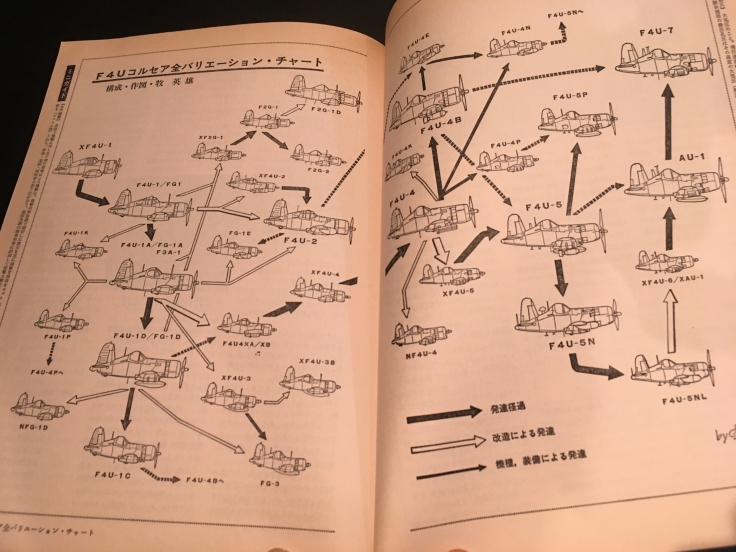
I have grouped the sub sub-variants by number because we can really go down an esoteric rabbit hole if we are talking about Corsair variants that were manufactured by Goodyear or Brewster.
Before I get into it, for those who do not know why the Corsair is called the F4U: It is very simple. This was the way planes were identified back in the 30s and 40s and was based on manufacturers and their individual designs. So for the Corsair XF4U-1 it went like this:
- X: Experimental (as in, not in production… yet)
- F: Fighter
- 4: 4th Design by this manufacturer
- U: The code for Vought Aircraft
- -1: the Mark of Corsair
XF4U-1 – The Prototype
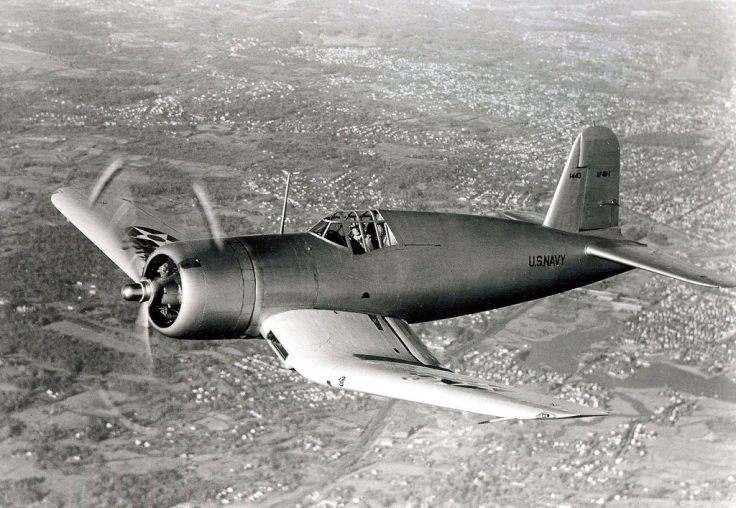
It all starts with the grand-daddy – the XF4U-1.
KEY DESIGN ELEMENTS
Keep in mind that when the Navy put out the request for proposals that resulted in the Corsair, they were still flying biplane fighters. To say the requirements were ambitious would be an understatement but given the rapid advances in airplane and engine design, the Navy did not want to risk being too far behind.
It would seem the main goal of the design was speed. The Corsair was designed to incorporate the most powerful engine at the time with the largest propeller and the smallest airframe possible. It’s this large propeller that required the wings to be “bent” – otherwise the landing gear would have to be considerably longer and more prone to damage on carrier landings.
FUN FACTS
The prototype Corsair was designed with ‘anti-aircraft bombs’ to be carried in mini-bomb bays within its wings. The thinking was that small bombs would be dropped on enemy aircraft formations. It also had extremely large balloons embedded in the top part of the wings that would deploy in the event of a water landing and keep the airplane afloat.
HOW TO MODEL
Unfortunately there is no kit of this Corsair variant. To make it you can go two routes:
- Kit bash: There is an excellent build article by David Weeks on Hyperscale and a few years ago this build was also featured in the IPMS USA Magazine.
- Conversion Kit: Lone Star Models was developing one (not released yet)
This project will be realized by me at some point – having the smaller prototype with all its 1930s design elements, silver fuselage and yellow wings would look great among the later versions that I have already built.
F4U-1 – the Birdcage Corsair

While the XF4U-1 prototype was fast (the first US fighter to fly faster than 400mph), there were a lot items that needed to be fixed before it would be accepted by the Navy. The production Corsair is commonly referred to as the “Birdcage Corsair” due to the window panes design on the canopy.
Key Design Elements
There are way too many changes from the prototype to list. However the main ones are that the armament was changed to six wing-mounted .50cal machine guns. This meant that the location of the wing fuel tanks had to be moved to the forward fuselage and THAT required the cockpit be moved back and the fuselage lengthened. This is why the first production Corsair looked very different from the prototype.
Operations
The Birdcage first saw action in early 1943 and first shot down Japanese fighters on February 14, 1943. The Birdcage was used operationally from land bases in the South Pacific.
Fun Facts
For a long time Birdcage Corsairs were among the rarest survivors. However, quite a few ended up at the bottom of lake Michigan during the war. These were due to practice landing mishaps aboard the USS Sable and a few have been recovered recently. Hopefully we see more restored Birdcage Corsairs as a result.
Can I see a real one?
Yes – but not easily. Unfortunately a lot of F4U-1s did not come back and those that did were used as trainers until their service lives were used up. But there are a few including a recently recovered Birdcage being restored. I am thinking there may be a few more pulled out of the great lakes.
How to Model?
There are plenty of kit options here:
- Tamiya F4U-1 Birdcage
- Academy F4U-1 Birdcage
- Hobby Boss F4U-1 Birdcage “Early” and “Late”
- Hobby Craft F4U-1 Birdcage
- AMT F4U-1 Birdcage
F4U-1A – Strike Fighter
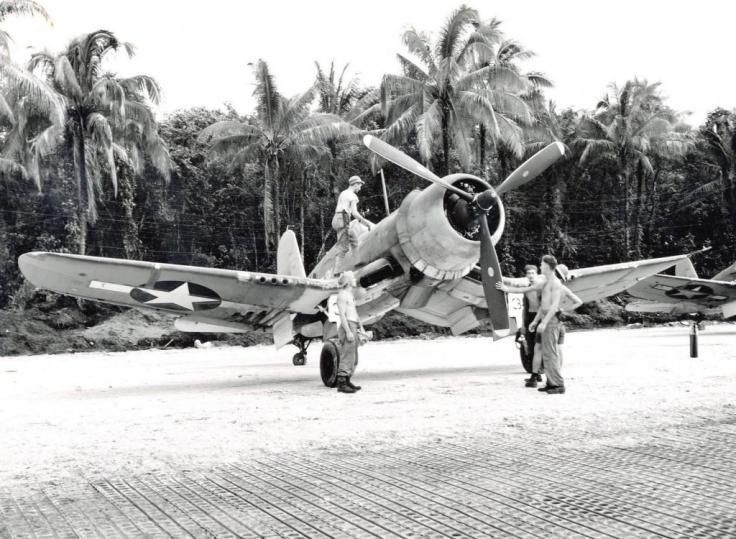
The Birdcage was fast and durable but the operations in the South Pacific required long ranges and for fighters to act as “strike aircraft”. So variant had the ability to attach a ventral fuel tank. Some even carried a somewhat “makeshift” bomb rack behind the cowl. The Corsair went from fighter to “fighter bomber”.
Key Design Elements
The difference between the -1A and the -1 Corsair is with the canopy: goodbye poor visibility framed birdcage canopy and windows on the sides of the “turtle deck” and hello somewhat less poor visibility framed “blown” canopy. The pilot’s position was raised again to help with visibility over the the nose.
Length was added to the height of the tail wheel and many (but not all) USMC squadrons removed the arresting hook. The “Brewster Bomb Rack” allowed the Corsair to safely release a 500 pound bomb and become a strike fighter.
Operations
When you think of the Tri-Color Corsair with a single bomb slung behind the cowl, this is the one. Operating on sand and coral runways with palms lining the sides. Think Solomons and island hopping in 1943-1944.
Fun Facts
Way back in the 1970s the F4U-1A was the star of a network TV show known as Baa-Baa Black Sheep. This show was based on the life and times of Pappy Boyington. The Corsair used in the show is the one you can see at the Planes of Fame museum.
Can I see a real one?
Yes you can – although there are not many:
- At the Planes of Fame museum in California
- At the National Museum of the Marine Corps in Virginia
How to Model?
Again, there are plenty of kit options here and there is not much to do to the kit. Keep in mind, there was a lot of parts swapping and mods in the field. So you could be seeing a -1A with a lot of -1D characteristics.
- Tamiya F4U-1A
- Academy F4U-1A
- Hobby Boss F4U-1A
- Airfix F4U-1A
- Hobby Craft F4U-1A
- AMT F4U-1A
- Otaki F4U-1A
F4U-1C – the “C” is for “Cannons”
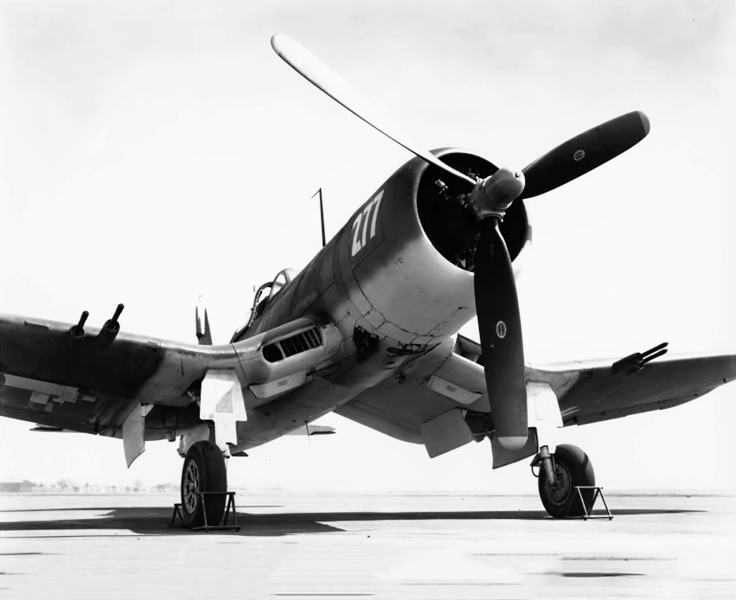
The -1A and was definitely an improvement over the Birdcage in every respect. But it didn’t have cannons! And as everyone knows, 20mm cannons are far better than .50 cal machine guns. Or are they?
Key Design Elements
200 of this variant were built from July to November 1944 for ground attack as well as fighter missions and was found to be especially potent in the ground attack role. However, the cannons and their ammunition affected flight performance and agility. Pilots also preferred the six machine guns because they were already more than powerful enough to destroy aircraft, had more ammunition and a higher rate of fire.
Operations
The F4U-1C was introduced to combat during 1945 in the Okinawa campaign.
Can I see a real one?
Yes and no. The Cavanaugh Flight Museum in Texas has a -1D that has been restored as a -1C. As far as I know, this is the only one.
How to Model?
There are no specific -1C kits out there. However, if you want to try a simple conversion it doesn’t much easier than this. You can start with pretty much any F4U-1A or -1D kit and make the necessary modifications. Here are two build articles that detail what needs to be done:
F4U-1D – Bombs, Rockets & Carrier Landings
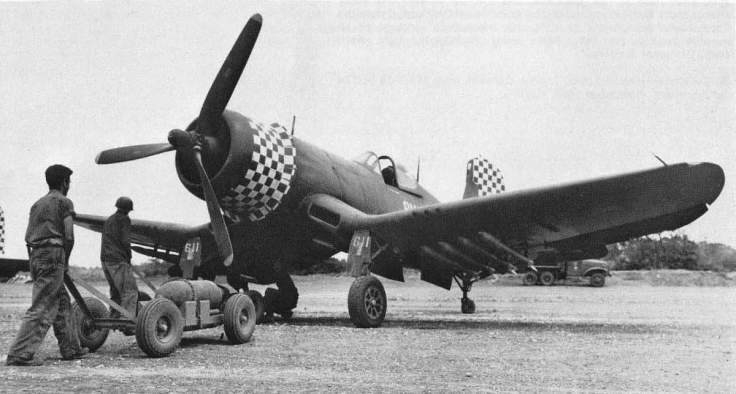
With the -1D the Navy finally had a fully carrier capable Corsair. The wicked stall was tamed with a block on the front of the starboard wing, the canopy shed its rails and this variant could carry all sorts of bombs, rockets and fuel tanks under the wings and fuselage.
Key Design Elements
The difference between the -1A and the -1 Corsair is with the canopy: goodbye poor visibility framed birdcage canopy and windows on the sides of the “turtle deck” and hello somewhat less poor visibility framed “blown” canopy. The pilot’s position was raised again to help with visibility over the the nose.
Length was added to the height of the tail wheel and many (but not all) USMC squadrons removed the arresting hook. The “Brewster Bomb Rack” allowed the Corsair to safely release a 500 pound bomb and become a strike fighter.
Operations
The Navy finished the war with this -1D Corsair. These were used in 1944 and 1945.
Fun Facts
I’m told the destructive power of the Corsair’s rockets was equivalent to a broadside of a destroyer. I do not know if that is true but I like to think that it is.
Can I see a real one?
Yes you can and there are a lot of them. They are too numerous to list but I think the Wikipedia page listing them is accurate.
How to Model?
In terms of modeling the Corsair, this is probably the easiest one. The difficulty I used to have with this variant was finding a good Gloss Sea Blue paint. There are now a lot of options to this colour.
- Tamiya F4U-1D
- Academy F4U-1D
- Hobby Boss F4U-1D
- Hobby Craft F4U-1D
F4U-2 – Night Fighting Corsair

So this is where the numbering of the Corsairs starts to not make sense. Clearly this is -1 that has been modified to add night fighting capabilities. And this was done very early in the war – before the -1A
Key Design Elements
The difference between the -1 and the -2 Corsair has everything to do with the mission of shooting down enemy planes at night. There is a radome on the starboard wing and one of the starboard machine guns was removed to compensate for the weight of the radome. There would have been some form of display in the cockpit for the radar. There were also a lot of antennae on the bottom of the fuselage.
Operations
The the -2 was the first Navy Corsair to be used operationally off carriers. This variant was used aboard the Enterprise and the Intrepid in early 1944 as well as the Solomon islands and on Tarawa.
Fun Facts
The original thinking was that the intermediate blue paint on these -2 Corsairs was painted over with black. Recent research has determined this was not so. However, there is very little intermediate blue on -2 Corsairs – the top colour was just brought down further on the sides of these fighters.
Can I see a real one?
I do not think so.
How to Model?
If you buy a Tamiya Birdcage Corsair, you will get most of the pieces needed to make the -2 night fighter.
- Tamiya F4U-1/2
- Academy F4U-1D
- Hobby Boss F4U-1/2
- Hobby Craft F4U-1D
The other aspects of the build are best determined with references. There are a lot of antennae on this variant. Also, a clear picture of the cockpit, particularly the instrument panel of the F4U-2 is considered one of the holy grails of research into this airplane.
XF4U-3
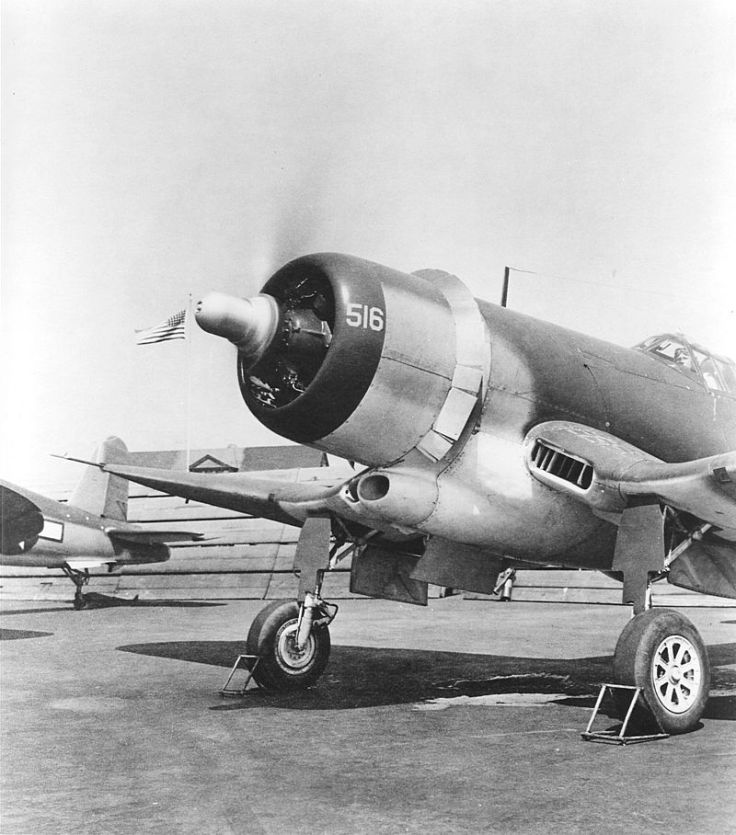
The idea behind this variant was to change the turbo-supercharger system in order to obtain greater speeds for the Corsair at higher altitudes.
Key Design Elements
The key would be the big housing for the new turbo system. Getting a clear picture or some plans for this is another “holy grail” in the Corsair modeling community. I believe the proposed system was unreliable but when it did work, there was a significant increase in speed at 30,000 feet.
Operations
This was an experimental fighter in 1944. Three were built and none were operational.
Can I see a real one?
No – all three were returned to the F4U-1 configuration.
How to Model?
A modeler would start with a birdcage and go from there. However, this would not be an easy one to do as there would be considerable guess work in creating the bulbous fairing for the supercharger.
F4U-4 – the Ultimate Corsair Fighter

So forget the previous numbering. When we get to the -4, the numbers reset and make more sense! This is also the last variant to see action during World War II with deliveries to the U.S. Navy taking place in early 1945.
Key Design Elements
The -4 Corsair retained the original armament and had all the external load capabilities of the F4U-1D. However, it had a new engine, new cowl, 4 bladed prop and significantly more power. Visually the exhausts changed from being at the bottom of the fuselage to the sides and there was an air scoop at the bottom of the cowl.
Operations
This variant was used by the Navy and the Marines in 1945 all the way through the Korean War. It was also used by National Guard units in the US.
Fun Facts
The F4U-4 was to be the ultimate air-to-air fighter for the US Navy in World War 2. Every issue with the F4U-1D was resolved in this variant. But by the time it was headed out to the Pacific, the war was winding down and saw little combat. By the time it saw combat again, it was years later in Korea.
Can I see a real one?
Absolutely and there are a lot of them. They are too numerous to list but I think the Wikipedia page listing them is accurate.
How to Model?
There is an easy way and a hard way to model the -4 Corsair. As for the easy ways there are kits:
- Hobby Boss F4U-4 Early & Late
- Hasegawa F4U-4
- Monogram F4U-4
Those last two are pretty old kits with raised panel lines but accurate parts. Before the Hobby Boss kits came along one could model a -4 with a F4U-1D by Tamiya and a conversion set by CMK. I did that and I am happy with the result but let me tell you, I wouldn’t do it again!
F4U-5 – Strike Fighter

By the time the -5 Corsair came about, the Corsair was being used for the ground attack role. The fighter role being taken over by other aircraft. This variant was a strike fighter and was extensively modified from the -4 Corsair.
Key Design Elements
These airframes were strengthened and built to take more ground fire. The new engine with dual superchargers required the front fuselage to be lengthened. To help with visibility, the long nose was also turned downwards slightly. The cowl was no longer round – more of a rounded triangle shape. The cockpit was completely changed and there were no more fabric surfaces on the wings, ailerons or elevators. Lastly, cannons replaced the .50 cal machine guns.
Operations
The -5 Corsairs served in Korea and were in ANG units in the US.
Fun Facts
A big brute with a ton of ordnance hanging from the wings. These were the last US Navy Corsairs produced.
Can I see a real one?
You sure can. And since this is a later variant, many of these are flying compared to the first variants of the Corsair.
How to Model?
For the longest time this was strictly modeled by Hasegawa who made a fine kit. I believe all -5 variants could be made from the Hasegawa kit. This kit was also sold under the Monogram “Promodeller” line as well as a more recent boxing by Revell.
- Hasegawa F4U-5
- Promodeller F4U-5
- Revell F4U-5
- Hobby Boss F4U-5
There were some issues with the Hobby Boss late variant Corsairs including fabric wings. I believe these might have been fixed in later boxings but I am not sure.
F4U-6 aka AU-1 – The last of the US Corsairs

This final version of the Corsair for US service was developed during the Korean War for Marine ground attack missions. The first AU-1 flew at the end of January 1952
Key Design Elements
The -6 or AU-1 was designed first and foremost as a ground pounder. It didn’t need the dual superchargers of the -5 but it did have a need for additional armour. That meant less power and a lower top speed but the number of under-wing rocket pylons was increased to ten.
Operations
Again, this variant was used in Korea by the USMC.
Fun Facts
F4U-6 or AU-1? Same thing. The name change was due to the new Aircraft designation system developed by the Navy in the 1950s.
Can I see a real one?
I don’t think so.
How to Model?
Hasegawa was your only choice for a long time and these are hard to find. Hobby Boss now has an AU-1
- Hasegawa – F4U-6
- Hasegawa – AU-1
- Hobby Boss – AU-1
.
FG2 – Unlimited Racer
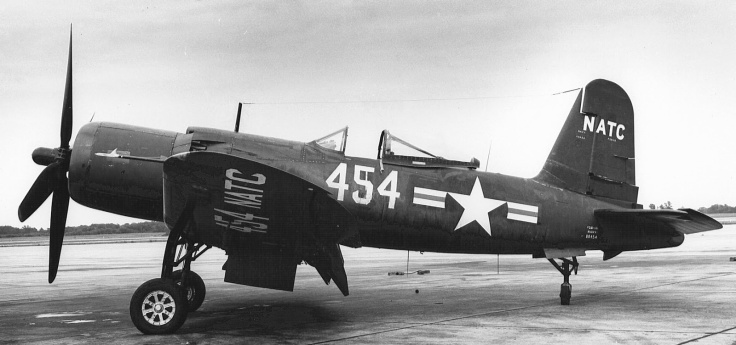
Back we go to the weird numbering again. Although this Corsair variant was developed during the Second World War, it definitely looked like a later variant due to the 4 bladed prop, massive engine and bubble canopy.
Key Design Elements
This variant was looked at as the F4U-1D was being developed for the US Navy and Marines. Most believe it to have been an answer to the Kamikaze issue the Navy was facing at the end of the war. But given the development timelines, this is probably not true. In the end, the massive engine and all of the additional weight of this aircraft were found to be not that much of an improvement over the F4U-1D and probably the F4U-4 on the drawing board.
Operations
This variant was never adopted by the Marines or the Navy.
Fun Facts
Despite it not being considered a “success” in military circles, after the war the “Super Corsair” went on to fame as an Unlimited Racer.
Can I see a real one?
Yes you can at the Seattle Museum of Flight.
How to Model?
Seeing as these Corsairs have almost nothing to do with any other variant, it would be very difficult to model them without a kit. Luckily for us, Special Hobby released such a kit about 10 years ago. The Accurate Miniatures version is just another boxing of the Special Hobby kit with different markings.
- Special Hobby F2G
- Accurate Miniatures F2G
Final Thoughts
So there you have it – a very quick guide to modeling the Corsair in 1/48 in US service. This should get you started but if you are interested in knowing more, there are plenty of books detailing how to model these wonderful planes. If I have missed a particular model or if I have messed up on my info in this guide, please feel free to let me know in the comments and I will update. Otherwise, let me know what you think!


Thanks for the run down on Corsairs and where to find them. What do you think of the post-war foreign service Corsairs, like with the French or Japan Self-Defense Force? I’d seen an odd Corsair model in the JMSDF Kanoya air museum, it had smaller vertical stabilizers mounted on the horizontal stabilizers and extra antennas mounted on it. Unfortunately no pictures are allowed in that part of the museum.
I’m working on a similar article you may like. It’s about Zero fighters in Japan and where to find them, since they’re still popular here and there’s a good number of originals and replicas around.
LikeLike
One of my favourites is the F4U-7 with its French markings and colorful Suez invasion stripes. I will do a “foreign” service entry for sure. I sure wish there were pictures of that Japanese Corsair. I don’t think they were used post war by Japan – at least I have never seen anything about that. There are some stories about captured Corsairs being test flown in Japan but no pictures. In any event I am very curious now!
And yes! I am very interested in your Zero article – please let me know when it is done. As much as I love the Corsair I have a fondness for the Zero as well. I have built 3 in various scales and I have pretty much every major variant in the model stash to be built one day.
LikeLike
The F4U-4 was NOT used by the Air National Guard, but by the Naval Air Reserves.
LikeLike
Oops! YES! that’s right.
LikeLike
I have a blog about VF(N)-101.
LikeLike
Type Richard Harmer and VF(N)-101 on Google.
LikeLiked by 1 person
Direct link… https://johnkellynightfighterpilot.wordpress.com
LikeLiked by 1 person
VERY COOL! Thanks!
LikeLike
I have learned a lot along the way. I will have to update several posts especially the ones with images of Corsairs. At the start, Corsairs numbers 8, 9, 10, 11 were on the Intrepid. Numbers 12, 13, 14, 15 were on the Enterprise. Then when the Intrepid was torpedoed, F4U-2s were given to Harmer since some of his Corsairs were damaged.
LikeLiked by 1 person
I have reblogged it here…
https://johnkellynightfighterpilot.wordpress.com/2019/09/22/the-quick-and-dirty-guide-to-modeling-the-corsair-in-us-service/
LikeLiked by 1 person
One of the times I feel like a fossil among youngsters. My modeling was in the 60’s. Monogram’s logo “quality hobby kits” spoke volumes. Little if any flash, parts which fit perfectly, and in the interests of realism, the working features. Having heard modelers refer to them as a “toy” is a blatant insult. The operating surfaces allow it to be displayed in several different ways, appealing to those who go to great lengths with “dioramas”. I thought Revell was very mediocre; finding out Revell bought Monogram disgusted me. More recent manufacturers for my money can go fly a kite.
LikeLiked by 1 person
I picked up a Monogram PBY a couple months ago. It is a subject that I wanted to model and the model is very good out of the box. In general they (Monogram kits) are good and have some excellent features. Fit can be a problem though and that leads to filling in those gaps and obliterating the raised panel lines. If it was feasible to update the molds with recessed panel lines, I think we would see a complete revival of these kits.
LikeLiked by 1 person
IF you had been able to purchase an original kit, the fit have been perfect. You speak of one of many Monogram kits I built. Some of these can be hunted down on E-bay.
LikeLike
This is a pretty good starting place for the model builder who wants to learn to genealogy of the Bent Wing Bird. I wrote a pretty extensive article on the F4U-2 which is published on iModeler.
https://imodeler.com/2017/06/a-corsair-for-bob/
Bob Brunson passed away not too long ago and the model was delivered to the Museum of the Pacific in Fredricksburg, TX.
On the subject of Goodyear and Brewster Corsairs, the story gets a lot more murky, especially for the Brewster F3A. Goodyear also adopted a somewhat different paint scheme for their Corsair, the F3A and i wrote an article about the prototype FG-1.
https://imodeler.com/2015/04/a-good-year-for-corsairs/
As for the Brewster F3A, there is a lot about the plane that we will never know, but a valuable piece of the puzzle is the beautiful F3A-1 restoration carried out by Ezell Aviation.
LikeLiked by 1 person
The “FG2 – UNLIMITED RACER” is of course the F2G 😉
LikeLike
Oh crap – you are right!
LikeLike